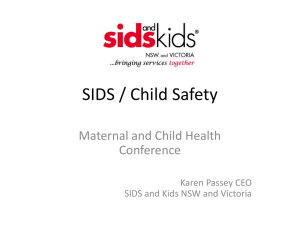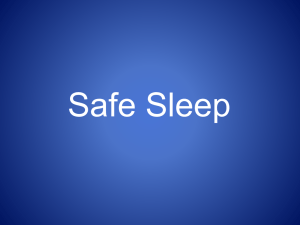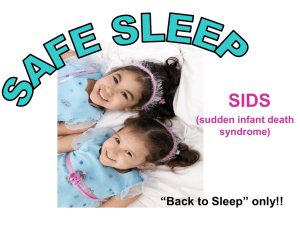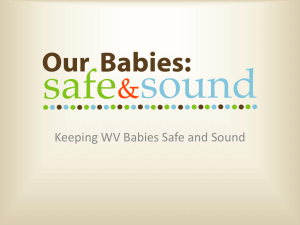Safe Sleep Environment - Dayton Children`s Hospital
advertisement
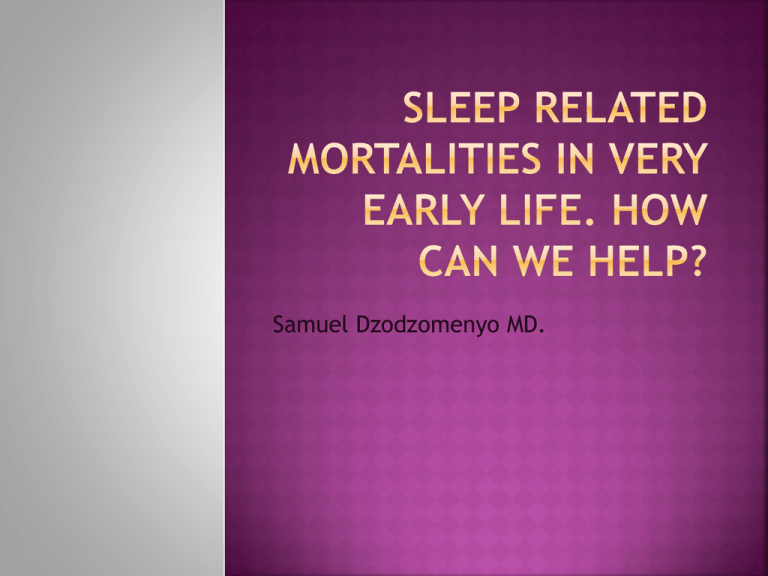
Samuel Dzodzomenyo MD. 1.To identify risk factors associated with sleep related mortality in infants 2. Understanding sleep-environment-related infant deaths. 3.Best practices to reduce sleep related infant death. The number of infant deaths (one year of age or younger) per 1000 live births Currently, the most common cause is pneumonia. Traditionally, the most common cause worldwide was dehydration from diarrhea Rank Country Infant mortality rate (deaths/1,000 live births) 1 Angola 180.21 2 Sierra Leone 154.43 3 Afghanistan 151.95 4 Liberia 138.24 5 Niger 116.66 219 Hong Kong 2.92 220 Japan 2.79 221 Sweden 2.75 222 Bermuda 2.46 223 Singapore 2.31 -6.84 in 2003 -6.78 in 2004 -Range: 4.67 (Asian & Pacific Islanders) -13.6 (Non-Hispanic Blacks) IMR United States/100,000 1. Congenital malformations 2. Low birth weight 3. SIDS Together account for 45% of all infant deaths Infant Mortality Rate (Deaths per 1,000 Live Births) by Race/Ethnicity, Linked Files, 2004-2006 OH US Non-Hispanic White 6.4 5.7 Non-Hispanic Black 15.9 13.5 Hispanic 5.6 5.5 Total 7.8 6.8 Ohio’s infant mortality rate of 7.7 per 1,000 births ranked eighth worst in the country in 2008. Montgomery County’s infant mortality rate that year was slightly higher at 8 per 1,000 births. -Indicator of health of present and future Populations - Indicator of health disparities among different populations - Indicator of overall health/ quality of life in a community SIDS is the unexpected death of seemingly healthy babies 12 months or younger. No cause of death is determined by Death scene investigation and autopsy. Review of baby’s medical history. Experts cannot predict which babies will die from SIDS. Sleep studies give no answers Revised – 12/08 2009: 4 deaths where sleep environment was determined to be a possible contributing factor but there was not enough information for the Coroner’s office to call it. 4 more deaths identified “position asphyxia” on the death certificate, so those are the easy ones! 2010: 3 sleep-related deaths for – one positional, one overlay and one “ unsafe sleeping” The exact causes of SIDS are unknown, but SIDS is NOT caused by Revised – 12/08 Immunizations Vomiting or choking Glial-neuronal interactions in the cardiorespiratory centre of the brainstem. Gastric reflux, and especially laryngopharyngeal reflux Role of serotonin in respiratory function and dysfunction Reduced ventilatory response to CO2 challenge in the prone position Impaired ability to respond to respiratory compromise Fast Facts About SIDS SIDS is one of the leading causes of death in infants between 1 month and 1 year of age. Most SIDS deaths happen when babies are between 2 months and 4 months of age. African American babies are more than 2 times as likely to die of SIDS as white babies. American Indian/Alaskan Native babies are nearly 3 times as likely to die of SIDS as white babies. Two thirds of US infants younger than 1 year are in nonparental child care. Infants of employed mothers spend an average of 22 hours per week in child care. 32% of infants are in child care full time. Less than 9% of SIDS deaths should occur in child care. Revised – 12/08 Ehrle et al, 2001 Approximately 20% of SIDS deaths occur while the infant is in the care of a nonparental caregiver. 60% in family child care 20% in child care centers 20% in relative care Infants tend to be Caucasian, with older, more educated parents. Revised – 12/08 Moon et al, 2000 Approximately 1/3 of SIDS-related deaths in child care occur in the first week, and 1/2 of these occur on the first day. Something intrinsic to child care? Not that we’ve found yet Stress, sleep deprivation? Unaccustomed Revised – 12/08 tummy sleeping? Yes -Requires the convergence of three elements that may lead to the death of an infant from SIDS: 1. Critical developmental period 2. Vulnerable infant 3. Outside stressor(s) -All three elements must be present for SIDS to occur. -Removing one or more outside stressors can reduce the risk of SIDS. Critical development period SIDS Vulnerable infant Revised – 12/08 External stressors -Stomach sleep position -Soft bedding -Tobacco smoke -Overheating -Infection Low birth weight (less than 5 pounds) Premature (less than 37 weeks) Maternal smoking during pregnancy Multiple births (eg, twins, triplets) Maternal age younger than 18 years Less than 18 months between births African Americans (2x greater risk) Partly genetic Partly behavioral (sleep position, bedsharing) American Indians (more than 2x greater risk) Secondhand smoke exposure Binge alcohol drinking during pregnancy Overdressing of babies • • • • Mothers who smoke during pregnancy (3x greater risk) Babies who breathe secondhand smoke (2.5x greater risk) Babies who sleep prone (on their tummies) or on their sides (2-3x greater risk) Babies put on their tummies to sleep who usually sleep on their backs or babies who roll over onto their tummies (as much as 18x) Launched in 2003 Activities Revised – 12/08 Increase awareness. Decrease incidence of SIDS in child care. Educate policy makers to include back-to-sleep positioning in child care regulations. SIDS Rate and Sleep Position, 1988-2003 (Deaths per 1,000 Live Births) 100 1.4 1.39 1.3 1.3 SIDS Rate 1.2 1.17 71.6 1.03 1 64.4 0.87 0.74 38.6 0.5 0.77 72.8 55.7 0.72 53.1 71.1 66.6 0.67 35.3 0.62 50 0.56 0.57 0.53 26.9 Percent Back Sleeping 1.5 17 13 SIDS rates have decreased and percent of back sleeping has increased since the campaign began. Revised – 12/08 20 03 20 02 20 00 20 01 19 98 19 99 19 97 19 95 19 96 19 94 19 92 19 93 19 90 19 91 0 19 89 19 88 0 Yellow (1985–1991): Pre-AAP recommendation Year Blue (1992–1994): Post-AAP recommendation Red (1995–1999): Back to Sleep campaign Source: National Institute of Child Health and Human Development Household Survey Final Data 2003, National Center for Health Statistics, Centers for Disease Control and Prevention They think that babies are more likely to choke or aspirate if they vomit or spit up They are worried that babies won’t sleep as well When babies sleep on the backs, they don’t develop normally. The baby’s parent(s) wants the baby to sleep on the tummy Revised – 12/08 Reasons that people place babies on their tummies Babies sleep better/longer/more deeply when they’re on their stomachs. The baby will get a flat head if the baby sleeps on the back. The baby will get a bald spot from sleeping on the back. When the baby is on the back, s/he startles more easily and wakes up. Revised – 12/08 Revised - 0408 Revised – 12/08 Lack of awareness 25% of licensed child care providers say they never heard of the relationship between SIDS and sleep position. Misconceptions Supine and aspiration, choking Belief that tummy sleeping improves infant comfort Parental Revised – 12/08 about risk of sleep position preference Lack of information Lack of education Tummy to play and back to sleep. Use safe sleep practices. Provide a safe sleep environment. Revised – 12/08 Supervised tummy time when babies are awake,2-3times a day. Promotes healthy physical and brain development Strengthens neck, arm, and shoulder muscles Decreases risk of head flattening and balding Encourages bonding and play between the supervising adult and the baby Back Revised – 12/08 to sleep Reduces the risk of SIDS Comfortable and safe Avoid Revised – 12/08 overheating. Do not overdress baby. Never cover baby’s head with a blanket. Room temperature should be comfortable for a lightly clothed adult. Always put healthy babies to sleep on their backs for naps and at bedtime. Do not have more than one baby per crib. Revised – 12/08 Pacifiers may be offered to babies to reduce the risk of SIDS Revised – 12/08 If breastfed, wait until breastfeeding is well established (approximately 3 - 4 weeks of age), before offering a pacifier. If the baby refuses the pacifier, don’t force it. If the pacifier falls out while the baby is asleep, you do not have to re-insert it. Safe crib, firm mattress. Avoid chairs, sofas, air mattresses, water beds, and adult beds. Revised – 12/08 May be hazardous under certain conditions. The American Academy of Pediatrics recommends that babies not bed share. Bed sharing is especially dangerous when Baby bed shares with someone other than the parents. Therefore, children or other adults should not bed sharing with an infant. Bed sharing occurs on a waterbed, couch, or armchair. The adult is a smoker. The adult drinks alcohol or uses medications or drugs that can make it more difficult to arouse or wake up. Revised – 12/08 The safest place for a baby to sleep is in a separate sleep surface (eg, bassinet, crib, cradle) next to the parents’ bed. Revised – 12/08 No excess bedding, comforters, or pillows Consider a blanket sleeper or sleep sack for the baby instead of a blanket if extra warmth is needed No bib around the baby’s neck Bumper pads are not needed Wedges or positioners are not recommended No toys or stuffed animals in the crib Be aware that parents like their baby to have things from home with them- help caregivers to identify other ways to allow this. Revised – 12/08 Maintain Revised – 12/08 a smoke-free environment The Montgomery County Child Fatality Review Board (CFRB) is charged with preventing infant deaths in our community. The goal is to raise awareness about unsafe sleep practices that lead to the death of infants less than one year of age. In Montgomery County nearly one baby a month dies due to unsafe sleep practices. Ohio’s infant mortality rate of 7.7 per 1,000 births ranked eighth worst in the country in 2008. Montgomery County’s infant mortality rate that year was slightly higher at 8 per 1,000 births. 2009: 4 deaths where sleep environment was determined to be a possible contributing factor but there was not enough information for the Coroner’s office to call it. 4 more deaths identified “position asphyxia” on the death certificate, so those are the easy ones! 2010: 3 sleep-related deaths for – one positional, one overlay and one “ unsafe sleeping” The ABCs of Safe Sleep. I sleep safest. Alone on my Back in a Crib. A Your baby should always sleep ALONE. -Some Moms and Dads sleep with their babies in an adult bed. Or, they allow babies to sleep with other children or pets. This is not safe. ----Baby’s mouth or nose can become covered, keeping the baby from breathing. - Your baby should sleep alone in a safe, empty crib. - Baby’s caregiver should be nearby, in the same room, but not in the same bed. - If your baby is in your bed to feed or comfort, put your baby in the crib for sleep. B Your baby should always be on his or her BACK to sleep. The safest position for babies to sleep is on their backs. (Your baby should always sleep on his or her back unless your doctor has instructed you otherwise for medical reasons.) • Keep baby’s room at 68 – 72 degrees. Not too warm. Not too cold. • Have baby in a one-piece sleeper or sleep sack. Baby will stay warm and comfortable. No blankets needed. • Keep the room smoke-free! C In a safe empty CRIB with a firm mattress. A safe crib is the best place for your baby to sleep. It is not safe for a baby to sleep in an adult bed, on a couch, chair, bean bag, waterbed, featherbed, futon or recliner. A safe crib has: • A firm mattress that fits the headboard and footboard tightly with no gaps. • A sheet and mattress that fit tightly. • No corner posts or cutouts in the headboard or footboard. • No missing slats. Also, slats are not more than 2 and 3/8 inches apart (about the width of a soda pop can). • No pillows, bumper pads, quilts, lamb skins, blankets, or stuffed toys. More information about safe sleep is in the Safe Sleep for your Baby brochure. You can find it at www.phdmc.org or by calling 937-225-4981. May save lives of babies Shows parents baby’s health and safety is your #1 priority Educates staff Revised – 12/08 Consistent care Educate parents Professional development It empowers child care providers If followed, helps reduce your risk of liability Revised – 12/08 Healthy babies always sleep on their backs. Obtain physician’s note for non–back sleepers. The note should include prescribed sleep position and the medical reason for not using the back position. Use safety-approved cribs and firm mattresses. Crib: free of toys, stuffed animals, and excess bedding. If blankets are to be used, practice feet-to-foot rule. Sleep only one baby per crib. Revised – 12/08 Room temperature is comfortable for a lightly clothed adult. Monitor sleeping babies. Have supervised tummy time for awake babies. Revised – 12/08 Elements of a Safe Sleep Policy • Teach staff, substitutes and volunteers about safe sleep policy and practices. • Provide parents with safe sleep policy. Revised – 12/08 Alternate Sleep Position • Inform all child care providers and substitutes. • Keep physician’s note in baby’s medical file and post notice on crib. Revised – 12/08 Discuss SIDS and risk reduction strategies with parents. Discuss sleep position policies. Discuss medical waiver and implications. Revised – 12/08 Implement the Caring for Our Children standards. Have a safe sleep policy. Train all caregivers. Talk with a child care health consultant. Be able to handle an infant medical emergency. Be aware of bereavement resources. Revised – 12/08 Have a plan in place. Review the plan with all staff periodically. Be sure you have received training and have successfully practiced rescue breathing and skills for handling a blocked airway for infants in a first aid course. Revised – 12/08 Teaching resuscitation skills may be useful. Call 911. Get help to care for the other children. Call the child’s parents or emergency contact. Call the parents of the other children. Do not disturb the scene (e.g., don’t try to tidy up). Notify licensing agency and insurance agency. Revised – 12/08 Investigation Several people will ask for the same information so they can help. Law Revised – 12/08 enforcement Note baby’s health, behavior, etc. Take photos. Limit disturbance of the area. Licensing agency Questions about licensing regulations. SIDS death not a reason for revoking a license. Coroner/medical Revised – 12/08 examiner Conducts autopsy. Determines cause of death. Infant Death Investigation? Comprehensive Forensic Investigation of Infant Death. Social History Family Information, Child Caregivers, Social Services, Child Protective Services, Other Scene Information Police, Forensic Investigator, EMS, Other Infant Death Investigation? Comprehensive Forensic Investigation of Infant Death. Medical History Pre-Natal and Birth History, Pediatric and Primary Care History, Other Forensic Autopsy External, Internal & Histological Examination, Toxicological and Microbiological Tests, Metabolic What SIDS is SIDS risk factors How to reduce the risk Caring for Our Children: National Health and Safety Performance Standards Developing a safe sleep policy Handling a medical emergency Resources for more information Revised – 12/08 • American Academy of Pediatrics 141 Northwest Point Blvd Elk Grove Village, IL 60007-1098 Revised – 12/08 Phone: 888/227-5409 Fax: 847/228-7320 E-mail: childcare@aap.org Web site: www.healthychildcare.org Back Revised – 12/08 to Sleep campaign www.nichd.nih.gov/sids Phone: 1-800-505-CRIB (2742) You can receive informational brochures, posters to provide to families and child care providers First Candle/SIDS Alliance 1314 Bedford Ave, Suite 210, Baltimore, MD 21208 Phone: 800/221-7437 or 410/653-8226 Fax: 410/653-8709 E-mail: info@firstcandle.org Web site: www.firstcandle.org National SIDS and Infant Death Program Support Center 112 E Allegan, Suite 500, Lansing, MI 48933 Phone: 800/930-SIDS or 800/930-7437 E-mail: info@sidsprojectimpact.com Web site: www.sidsprojectimpact.com Revised – 12/08 National 866/866-7437, www.sidscenter.org CJ Revised – 12/08 SIDS/Infant Death Resource Center Foundation for SIDS 888/8CJ-SIDS (825-7437), www.cjsids.com Public health clinics Home visiting programs Hospitals—in L&D, pediatric units and outpatient clinics, EDs, OB clinics Emergency services Churches Community organizations But it’s not easy – we must move “Beyond Basic Brochure Distribution” Is needed to change social norms about sleep-environment-related risks Needs to be addressed early and often! Must involve credible “key informants” or “key influencers” Should be institutionalized in settings such as newborn nurseries and pediatrics. Must address barriers to adoption and opposing messages Must be repeated and reinforced – at the community level Police and EMS personnel, if educated, can provide us with essential information Such as the presence and/or use of a crib; sleep position, etc Day care providers,baby sitters, grandparents , and others who care for infants must be included Physicians, nurses, child birth educators and social services providers are valuable influencers The child passenger safety community (can integrate infant sleep safety and installation of infant safety seats) The media

